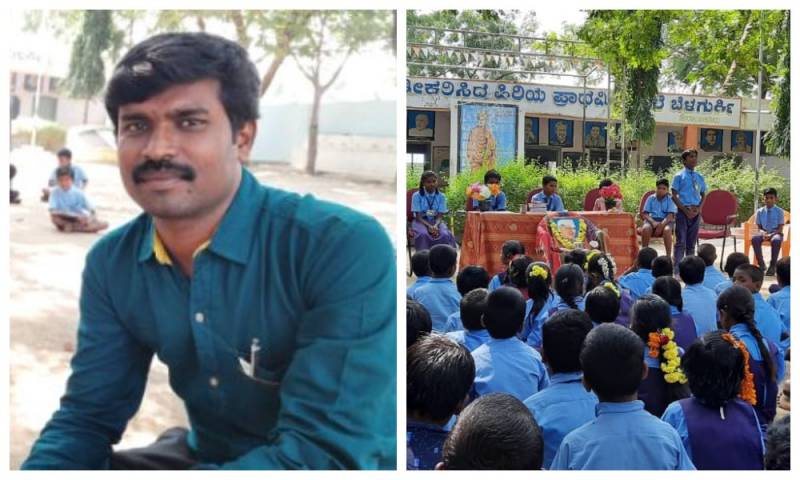School teacher transforms mindset of villagers with a magazine by students
By Jinka Nagaraju
Hyderabad: It is universally known that a school’s physical environment and extra-curricular activities play a crucial role in stimulating a positive attitude towards learning among students. A teacher in Karnataka has proven that a poor physical environment like a run-down building also exerts an equally negative impact on the minds of parents. An unattractive school, he said, fails to inspire the rural parents to send their kids to school since it cannot reassure them as an alternative learning space after home.
This realization made Kotresha Bavihalli, a government school teacher of Belagavi, Sindhanur Taluka, Raichur district, Karnataka, to transform the school’s environment first to change the perspective of illiterate parents towards village school.
Coupled with a school magazine, the beautiful school concept, teacher brought down the drop-out rate dramatically from 60 percent to nil today. And this school is now thriving as one of the best government schools in the state.
Kotresha narrated to this writer how hard he struggled to convince the parents to enrol their children in the school. Now, the school, which was once untouchable, is a vibrant partner of the social life of the village.
A postgraduate in English with B.Ed, Kotresha had a flair for writing. When he was first posted in this village school in 2004, he was totally upset. The school was a single-room shed with asbestos sheets that did not fully cover the roof. Except for walls, there was nothing. There were about 110 students on rolls, but they never would show up at the school.
And he was the only teacher for all classes 1 to 5. It took no time for him to get disillusioned with erratic students. Fed up, 23-year-old Kotresha requested the authorities to shift him to any school where there were children who are interested in learning. But his request was turned down by the authorities. This refusal to entertain his transfer petition forced him to seriously think of ways to change the attitude of villages towards the school.
Belagurki is a village of about 550 households with a population of 3000. As much as 60 percent of the villagers are labourers. Engaging the children on the farm work would supplement the family income. He found that the dilapidated shed had failed to enter villagers’ consciousness as a place of learning. Then he decided to change the image of the school and see the result. He pooled a lakh of rupees to purchase an acre of land to get a few more classrooms constructed to give the place a semblance of a school. It took six years to get the three rooms sanctioned. At the same time, he started planting saplings. With new rooms, the school was upgraded first to sixth class then to eighth class. By the time the rooms were completed, the school had acquired a garden-like appearance with impressive greenery.
Later, Kotresha had embarked on the mission of disengaging the children from farm labour by stimulating their creative talents. He started a Kannada magazine called Pencil and made all his students writers and journalists. It tickled the artistic skills of every child in the school and encouraged them to write and draw whatever they could.
He launched the first printed magazine by the students in the area with his own money, in 2013.
First, the magazine reached the households of students of the school. He slowly improvised the content by adding columns on interviews, local cultural events, festivals, medical camps, VIP visits, etc. “With local news capsules, drawings, poems by students, the four-page monthly Pencil soon became a household name. Parents had proudly started struggling to read the writings of their children. The magazine had become a talking point in the village and positively affected the thinking of the people.
He trained the students in interviewing the local artists, farmers, village elders, etc. Now the Pencil is available in some neighbouring villages and schools as well free of cost. Students are now quite often seen transforming the school into a colourful place with graffiti. It is the most talked-about school in Karnataka now.